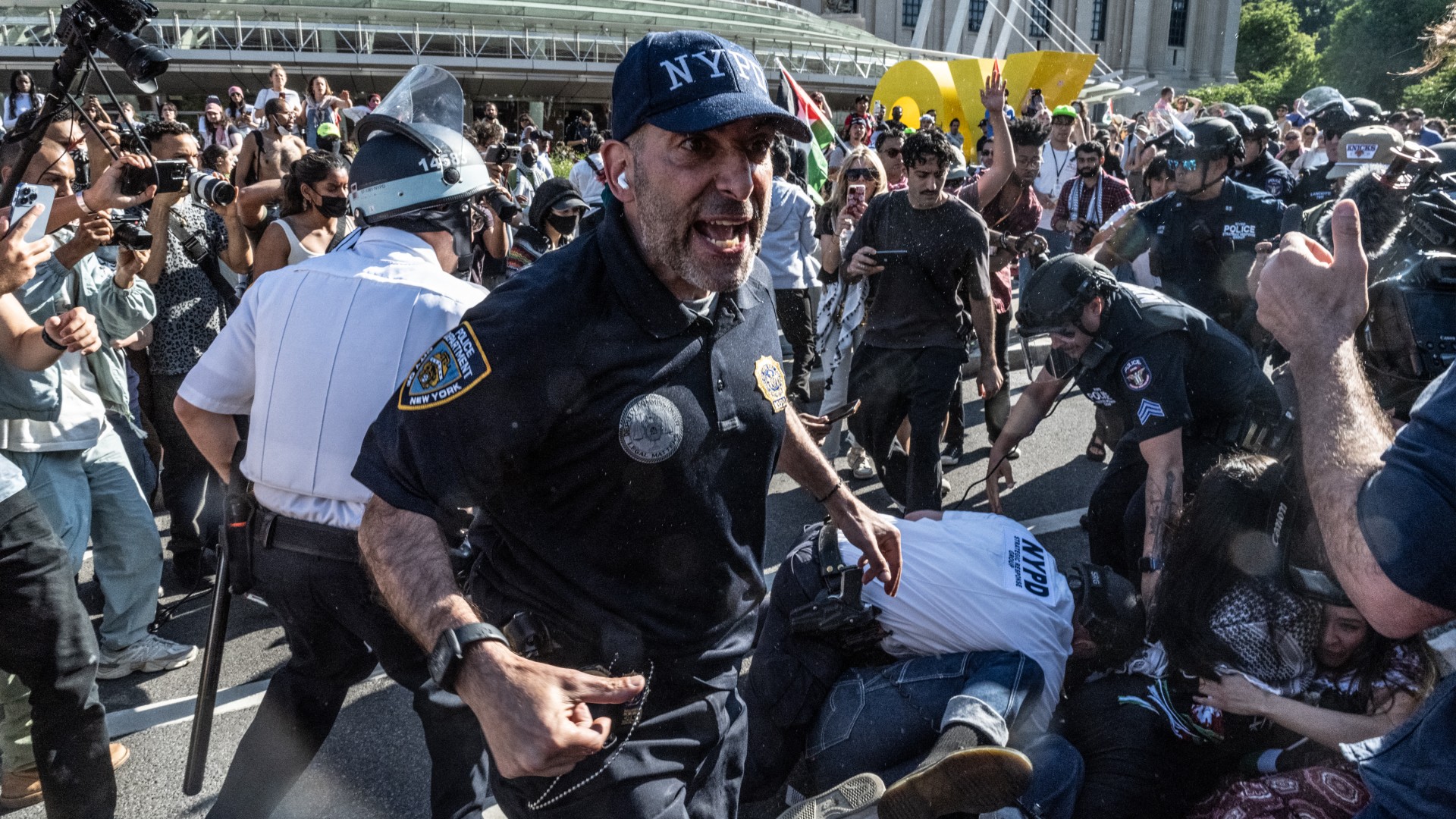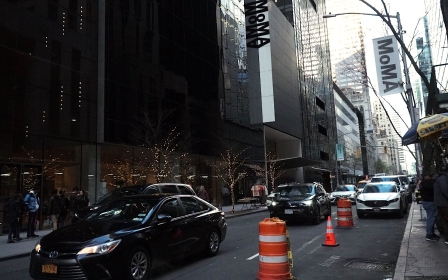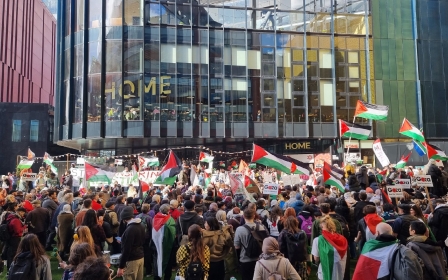Why pro-Palestine protesters are targeting the Brooklyn Museum

On Wednesday morning, the homes of four executives from the Brooklyn Museum were smeared with red paint and grafitti accusing them of having "blood on their hands".
At the home of Anne Pasternak, the director of the Brooklyn Museum, a banner with the words "white-supremacist Zionist" was stretched out between two pillars outside her front door.
No group has claimed responsibility for the actions but the incident sparked immediate backlash from the political establishment.
NYC's Mayor Eric Adams described the act as "unacceptable antisemitism" and added that the city's police department would investigate and "bring the criminals responsible here to justice".
New MEE newsletter: Jerusalem Dispatch
Sign up to get the latest insights and analysis on Israel-Palestine, alongside Turkey Unpacked and other MEE newsletters
Similarly, Senator Chuck Schumer, a Brooklyn native, called the incident "vile" and "nasty".
"It is un-American and, sadly, this kind of evil is something every Jew on Earth can recognise in an instant," Schumer said on the Senate floor on Wednesday.
Activists familiar with the months-long advocacy against the Brooklyn Museum told Middle East Eye that the action outside the four director's homes was not targeting the religious identity of the board members.
Out of the four people targeted, only Pasternak was Jewish.
The action outside the executives' homes, the activists said, was in protest against the complicity of the museum's leadership with Israel's continued war on the Palestinians in Gaza.
The case against the Brooklyn Museum
For months, activists and museum staff have been calling on the museum to publicly condemn the war on Gaza and to disclose and divest from investments linked to Israel's actions in Gaza.
As early as November last year, a month after the Hamas-led attack of 7 October sparking Israel's devastating war on Gaza, hundreds of Brooklyn Museum workers and affiliates signed a letter calling on the museum to speak out against genocide.
The letter demands the museum "unequivocally recognise Israel's ongoing actions in Gaza as genocide of the Palestinian people; to stand with Palestinians as they resist violent colonial occupation and apartheid; and to call on our colleagues in the cultural field, as well as our Brooklyn Museum community, to join this movement".
"American institutions' silence on this matter contributes to the erasure of this genocide from the historical record; with this letter, we aim to correct that while making it clear that at this crucial moment, we will not become complicit by remaining silent."
The Brooklyn Museum did not reply to MEE's request for comment.
One organiser, who helped mobilise actions against the museum, said the museum's refusal to listen to its staff and the community amounted to "paying lip service to concepts like 'decolonisation' and 'abolition'".
"The Brooklyn Museum in particular was targeted (as it has been targeted so many times before over the years) for its complicity in the genocide through its corporate funding from sponsors like Bank of America, Dior and Bank of NY Mellon which directly financially contributes to the Israeli Occupation Forces (IOF)," the organiser, speaking on condition of anonymity, told Middle East Eye.
In December, as the death toll in Gaza began to spiral, activists called for an end to the museum's corporate partnership with Bank of New York Mellon (BNY Mellon).
BNY Mellon allegedly has investments worth $10m in Israeli arms manufacturer Elbit Systems. In April, a BNY Mellon spokesperson told the Financial Times that it held "only a very small percentage of Elbit Systems' stock as a result of requirements by its passive index investment strategies on behalf of clients".
"The Brooklyn Museum, like so many other arts institutions, are imperialist and Zionist institutions that use art as a cover to hide and wash the blood on their funders' hands," the organiser, added.
Police brutality
On Wednesday morning, activists said they had targeted the homes of several museum executives, including Barbara Vogelstein, chair of the Board of Trustees and a former venture capitalist; Kimberly Panicek Trueblood, the chief operating officer for the board and a former aide to former US President Barack Obama; and Neil Simpkins, the treasurer for the board, who is also an executive, at Blackstone, one of the world's largest investment firms.
The direct action against the museum's top brass came two weeks after the New York Police Department (NYPD) violently broke up protests in and around the Brooklyn Museum during a massive protest organised by a coalition of groups including the Cultural Front for Palestine and Within our Lifetime (WOL).
During the protest on 31 May, pro-Palestine protesters had marched to Brookyn Museum, set up tents in the lobby and unfurled a "Free Palestine" banner from the building's roof before the police were reportedly called in.
Images captured on 31 May saw police officers tackle and beat protesters in what activists are claiming as systematic police brutality at pro-Palestine protests, particularly those arranged by WOL.
More than 34 people were arrested, including WOL's Chair Nerdeen Kiswani. Democracy Now reported that police tackled her to the ground and ripped off her hijab.
Rhea Nayyar, a journalist with Hyperallergic, wrote that "the scale of police force deployed on May 31 far surpassed that of other pro-Palestine museum actions across New York City in the last eight months covered by Hyperallergic."
"Notably, banner unfurlings, sit-ins and other such interventions managed to proceed at the Solomon R. Guggenheim Museum, the Metropolitan Museum of Art and the Whitney Museum of American Art without any arrests despite heavy police presence," Nayyar noted.
The activism around the Brooklyn Museum has gained in intensity as Israel's war on Gaza continues to rage.
More than 37,000 Palestinians have been killed, tens of thousands of others injured and more than a million displaced several times over since October. Despite calls for a ceasefire from a majority of countries around the world, as well as the UN Security Council, the bombardment of Gaza has continued.
Activists say there has to be a cost for institutions continuing to support a country that continues to defy international law and consensus.
'The Brooklyn Museum is an institution tainted with the blood of our martyrs'
- New York-based organiser
Meanwhile, incidents of repression against those advocating for Palestine continue to spiral, with pro-Israel supporters continuing to present accusations of antisemitism to smear advocacy around ending the war on Gaza.
On Thursday, as news spread about the red paint and graffiti outside the executives' homes, several publications described the four officials as Jewish, including the New York Times, which issued a correction hours later.
American museums have become hotbeds of action since Israel began its war on Gaza.
Hundreds of artists have called into question the silence of creative spaces, like museums, and noted their links to companies profiteering from the Israeli occupation of Palestinians.
In March, around 350 artists and cultural workers took part in a rally outside the Metropolitan Museum of Art in NYC, where they unfurled a massive quilt entitled "From Occupation to Liberation".
At the time, the group Hope in the Art World, said they had called for a protest "to make several clear demands: that the publicly funded museum (1) cut ties with board members who profit from the ongoing Israeli bombardment and settler-colonial occupation of Palestine, (2) support an immediate and permanent ceasefire in Gaza and (3) aid in the preservation of Palestinian cultural heritage sites being destroyed and desecrated by Israel".
There have been several incidents of censorship at museums, too.
In March, a visitor to the Museum of Modern Art (MOMA) in New York was prevented from carrying a keffiyeh inside the building.
MOMA later issued an apology, which the visitor rejected, over the museum's continued silence on Gaza.
"The Brooklyn Museum is an institution tainted with the blood of our martyrs," the organiser told MEE. "It is a nexus of Zionism, imperialism and settler-colonialism. The museum's complicity in the Palestinian genocide is a filthy inescapable reality and so is its violence against those protesting it."
Additional reporting and research by Violet Barron.
Middle East Eye delivers independent and unrivalled coverage and analysis of the Middle East, North Africa and beyond. To learn more about republishing this content and the associated fees, please fill out this form. More about MEE can be found here.






